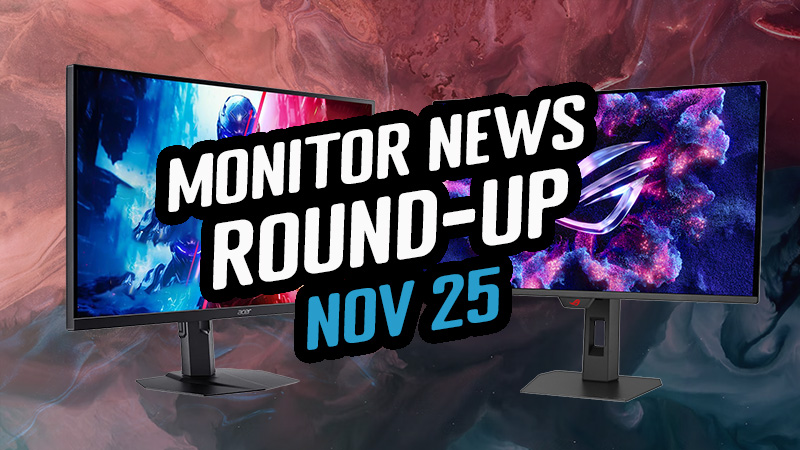VESA Introduce new ClearMR and DisplayHDR Tiers to Accommodate the Latest Displays

Ahead of CES next week, VESA have announced some updates to their ClearMR and DisplayHDR schemes to help accommodate the latest OLED display specs and capabilities. These updates include the addition of new performance tiers for VESA’s ClearMR standard for measuring motion blur that are designed for the next generation of ultra-high-refresh-rate displays for competitive gamers, such as 480-Hz and above displays. They also include a new 1000 luminance performance tier for VESA’s DisplayHDR True Black standard to validate new OLED displays featuring the high luminance and greater colour accuracy necessary to support professional video content creation.
VESA and its member companies will showcase product demonstrations of its latest video standards, including the new ClearMR and DisplayHDR True Black performance tiers, at the Consumer Electronics Show (CES), taking place next week in Las Vegas, January 7-10.
New Performance Tiers for the ClearMR scheme

First introduced in 2022, VESA’s ClearMR standard and logo program provides a quality metric for grading motion blur in displays. The “Clear Motion Ratio” (CMR) metric, as defined in the ClearMR standard, provides a clear numerical value based on the ratio of clear pixels to blurry pixels as a percentage, which enables consumers to easily compare the amount of motion blur between VESA Certified ClearMR displays. We’ve talked in the past about how some of this is calculated and tested, along with some reservations and concerns we have about the scheme in general. Check out our previous article on the topic for more thoughts on that.
For the purpose of this news piece and the update being announced for CES, the latest update to the ClearMR standard adds three new performance tiers—ClearMR 15000, ClearMR 18000 and ClearMR 21000—to help verify and ensure optimal motion clarity performance for the latest cutting-edge displays, including 480Hz and higher refresh-rate displays. This is largely being driven by the rapid acceleration of OLED monitors which have now reached 500Hz with recent announcements for CES. The range now spans from ClearMR 3000 at the bottom end, up to 21000 at the top end – the higher the number, the better the motion clarity should be.

Gigabyte, MSI and LG Electronics are all embracing the ClearMR scheme and these new tiers to help certify their latest displays. LG’s 27GX790A was the first monitor in fact to achieve the new ClearMR 21000 tier certification thanks to its 480Hz refresh rate OLED panel.
A New Performance Tier for ‘DisplayHDR True Black 1000’

DisplayHDR has been around a while, but VESA are now adding a new tier for their ‘DisplayHDR True Black’ scheme that certifies OLED displays. The latest update to the DisplayHDR True Black standard adds a new 1000 luminance performance tier to validate new OLED displays that provide the same extremely deep black levels of the other True Black performance tiers, but with higher luminance levels to support new applications such as professional video content creation.
New tier requirements and specs
The way these tiers work for OLED displays is a little more complicated than on LCD panels due to the way OLED panels operate and their Automatic Brightness Limiter (ABL) feature that controls power usage. You might think that most OLED monitors offer a “peak brightness” spec of above 1000 nits anyway already, which they do. However, those screens have only so far been certified under the VESA DisplayHDR True Black 400 tier. That’s because to achieve any of these certifications the screen needs to be able to reach the listed brightness number for a 10% APL window area. So while current OLED monitors might reach 1000 – 1300 nits peak brightness, that’s only for small 1 – 3% APL window areas. The brightness drops off significantly for larger APL areas and so they have so far only been certified under the TB400 tier.

The requirements for the new TB1000 tier are:
- 1000 nits brightness for 10% APL
- 500 nits full screen brightness for 100% APL
For an OLED monitor to be certified under the new True Black 1000 tier, it will need to be able to reach 1000 nits for a 10% APL, which should also then mean it will reach even higher for smaller APL – pushing up “peak brightness” specs further we expect. It must also be able to reach 500 nits for a full screen (100% APL) which is again beyond the current panel capabilities, which typically top out at around 270 – 280 nits at the moment.
Other spec requirements for colour gamut, colour depth, black depth etc remain unchanged from the previous tiers available, although the requirements for “Average ΔTP color error for each set of 96 colors at 50 & 100 cd/m2, and 50% of tier” have been tightened slightly for this new tier from dE 8 to dE 6.
You can find the full performance criteria here.
When will True Black 1000 certified monitors be available?
We’ve recently seen a new MSI QD-OLED monitor announced that is listed with the VESA DisplayHDR True Black 500 certification, which is a first. That in itself requires a bit of an improvement over previous OLED monitors, necessitating a 300 nits full screen (100% APL) brightness instead of the 250 nits that the True Black 400 tier needed. It also requires a 500 nits brightness for a 10% APL, instead of the 400 nits before.
For a screen to achieve the TB1000 tier, it will need to reach 500 nits full screen (100% APL) and 1000 nits for 10% APL as we explained earlier. That is another significant jump in OLED brightness for desktop monitors, so it feels like screens with this spec could be some way off. Although VESA are saying that you can “see new product demonstrations first-hand” at CES so perhaps there will be some models announced or shown in prototype stage at the event next week. Samsung Display (the panel manufacturer) have been working very closely with VESA on these new schemes as well, and so it’s likely advancements will be made in their QD-OLED panel technology first.
Source: VESA
Stay up to date on all the CES 2025 news
We will be at CES in January to bring you all the news and coverage from the event. New product launches, screen showcases and the latest releases. Make sure you subscribe to our YouTube channel to stay up to date there!
We may earn a commission if you purchase from our affiliate links in this article- TFTCentral is a participant in the Amazon Services LLC Associates Programme, an affiliate advertising programme designed to provide a means for sites to earn advertising fees by advertising and linking to Amazon.com, Amazon.co.uk, Amazon.de, Amazon.ca and other Amazon stores worldwide. We also participate in a similar scheme for Overclockers.co.uk, Newegg, Bestbuy , B&H and some manufacturers.
Stay up to date
 |  |  |  |
| Browser Alerts | Follow on X | Subscribe on YouTube | Support Us |
Latest Monthly News Round-up

Popular Trending News
 HKC M10 Ultra Announced with the World’s First RGB-Mini LED Backlight December 15, 2025 HKC (HKC Technology) have recently announced the upcoming launch of their M10 Ultra monitor, the World’s first to feature an RGB-Mini LED backlight which offers a range of new capabilities and some potentially impressive performance if it can live up…
HKC M10 Ultra Announced with the World’s First RGB-Mini LED Backlight December 15, 2025 HKC (HKC Technology) have recently announced the upcoming launch of their M10 Ultra monitor, the World’s first to feature an RGB-Mini LED backlight which offers a range of new capabilities and some potentially impressive performance if it can live up… Asus ROG Strix 5K XG27JCG Announced with a 27″ 5K 180Hz Fast IPS Panel and Dual-Mode December 15, 2025 If you are looking for a display which delivers Ultra-clear visuals and smooth and fluid gameplay, look no further than the Asus ROG Strix 5K XG27JCG. This 27” screen built around a ‘Fast IPS’ panel, boasts a 5120 x 2880…
Asus ROG Strix 5K XG27JCG Announced with a 27″ 5K 180Hz Fast IPS Panel and Dual-Mode December 15, 2025 If you are looking for a display which delivers Ultra-clear visuals and smooth and fluid gameplay, look no further than the Asus ROG Strix 5K XG27JCG. This 27” screen built around a ‘Fast IPS’ panel, boasts a 5120 x 2880… Gigabyte MO27Q28G Finally Available in the US December 17, 2025 Originally published 9th Dec 2025, last updated 17th Dec 2025 The eagerly anticipated Gigabyte MO27Q28G has finally appeared in the US to buy, after being launched across other regions like the UK and much of Europe over the last couple…
Gigabyte MO27Q28G Finally Available in the US December 17, 2025 Originally published 9th Dec 2025, last updated 17th Dec 2025 The eagerly anticipated Gigabyte MO27Q28G has finally appeared in the US to buy, after being launched across other regions like the UK and much of Europe over the last couple… LG 27GX790B is Unleashed with 27″ 540Hz 4th-Gen WOLED Panel and 720Hz Dual-Mode Support December 10, 2025 Hot on the heels of the ViewSonic XG273F-2K-OLED is another high-end gaming monitor offering amazing speed and the fastest refresh rates available so far from any OLED monitor. The LG 27GX790B is part of LG’s UltraGear range and features a…
LG 27GX790B is Unleashed with 27″ 540Hz 4th-Gen WOLED Panel and 720Hz Dual-Mode Support December 10, 2025 Hot on the heels of the ViewSonic XG273F-2K-OLED is another high-end gaming monitor offering amazing speed and the fastest refresh rates available so far from any OLED monitor. The LG 27GX790B is part of LG’s UltraGear range and features a… Philips and AOC Announce Their First 1000Hz Gaming Screens December 9, 2025 Image source: Philips Just when you thought refresh rates couldn’t get any faster Philips and AOC have introduced newly developed monitors capable of reaching mind boggling speeds of 1000hz! The Philips Evnia 27M2N5500XD and the AOC AGON Pro AGP277QK, have…
Philips and AOC Announce Their First 1000Hz Gaming Screens December 9, 2025 Image source: Philips Just when you thought refresh rates couldn’t get any faster Philips and AOC have introduced newly developed monitors capable of reaching mind boggling speeds of 1000hz! The Philips Evnia 27M2N5500XD and the AOC AGON Pro AGP277QK, have…

